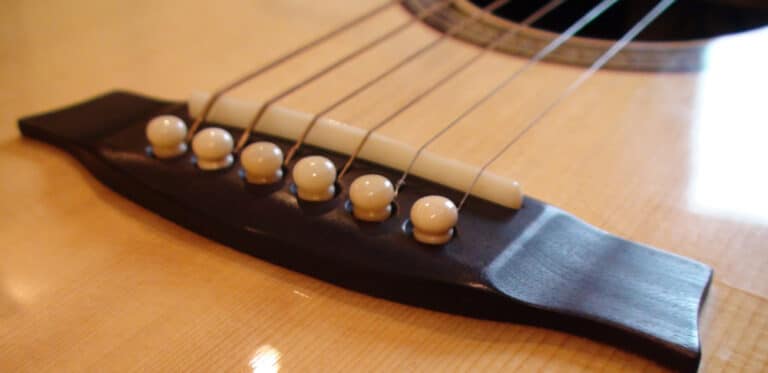Do Acoustic Guitar Saddles Wear Out?
Do acoustic guitar saddles wear out? Yes, although how quickly depends largely on the saddle material. Inexpensive plastic saddles wear out much more quickly than saddles made of other materials do. Let’s review what causes acoustic saddles to wear out, the problems wear causes, and how to replace a saddle with deep string grooves.

Saddle Wear Causes
Saddle Material
The key factor with saddle wear is the material. Inexpensive plastic saddles are often weak and will not last long. Additionally, inexpensive overly porous bone saddles processed with harsh chemicals will have a chalklike substance that does not last long. These inexpensive saddles might last a few months or years, but will soon produce deep saddle grooves. Higher quality manmade materials, such as Tusq, or quality bone saddles will last much longer.
Saddle Grooves
Unlike nuts, saddles do not come with pre-cut string slots. We suggest that you do not cut slots for your strings in the saddle. Doing so “pinches” the sides of the strings and produces a slightly muted sound. (On a related note, we’ve found that guitar nuts produce slightly better tone when the wound strings are half in and half out at the nut. Please see the Reduce Surrounding Nut Height section at this link for more information. )
String tension will keep the strings in place on top the saddle, provided that they have sufficient break angle. If your guitar lacks sufficient break angle, then the strings may be moving around loosely on the saddle.
This allows a bit more vibration and improves the tone a bit. However, at some point someone may have cut saddle slots, either because of the insufficient break angle problem discussed before, or in an effort to lower the action. Or, your saddles has grooves worn from the strings over time. If your saddle has had slots cut or worn grooves, we advise that you get a new saddle.
Problems with Saddle Wear
Strings dug into the saddle will result in lowered action, which can cause poor tone and/or buzzing. However, string grooves can also result in poor playability. Some strings will dig further and more quickly into the saddle than others will. This can produce an inconsistent radius, which can lead to poor playability.
How to Replace a Saddle with String Grooves
If your current saddle already has deep grooves for the strings, you might be tempted to simply smooth the saddle top with a radius block, then replace. However, this will result in a lower action, which could cause buzzing and/or tone loss. You could use a shim underneath the saddle to eliminate buzzing. However, shims often result in a loss of tone.
As such, we advise replacing the saddle altogether. First, remove your current saddle. Visit our article on How to Remove Guitar Strings without Completely Restringing for tips. Once removed, measure your current saddle’s maximum height, then add 1.5 mm to account for the string grooves. Using this as a maximum height find a saddle that is this height or taller. You can then find adjust to your guitar using the tips in our video on How to Replace an Acoustic Guitar Saddle.
